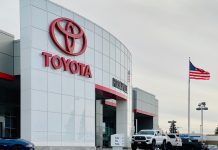In this segment of Fast Talk, vAuto’s Brian Finkelmeyer and Patrick Janes discuss the challenges dealers face as rising pressure of expenses coupled with the diminishing grosses, continue to compress margins. Brian and Patrick advise dealers on how to navigate our currently robust used-car market and take advantage of it in order to grow your business and overcome those expense challenges. And Patrick mentions one of the most important factors that can help with this problem: sourcing. To hear more check out the full episode above.
VIDEO TRANSCRIPT:
You’re watching Fast Talk with Brian and Patrick, sponsored by vAuto.
Brian Finkelmeyer: Hi, welcome to Fast Talk with Brian and Patrick. This is a show about the biggest trends and challenges facing today’s new car dealers, and some of the best ideas we’ve picked up in our travels across the country. I’m Brian Finkelmeyer and I cover the new car business at vAuto, and this is my partner, Patrick Janes, who handles our used-car business.
Brian Finkelmeyer: Well, let’s jump right into it. One of the biggest challenges facing dealers this year has been the rising pressure of expenses coupled with the diminishing grosses that we’re seeing as margins continue to be compressed. Patrick, what are you seeing in your travels on how dealers are combating this problem?
Patrick Janes: Brian, expenses are a challenge, but let’s start with some positive news here. This is a robust used-car market that we’re dealing with right now, and really what it comes down to is taking advantage of that. If we can grow our used-car business, that will do a lot to help with those expense challenges that we have right now.
Patrick Janes: And the one thing I’m talking to dealers about on a daily basis is sourcing. Where are they getting their used-cars from?
Brian Finkelmeyer: So this is an interesting point, Patrick, because everything I see is just telling me that there’s a lot of used-cars at auction, but they’re getting all the money. So how are dealers able to make any profit if we’re paying 93- 94% cost to market at auction?
Patrick Janes: Well, that just goes to show how strong the used-car market is because everybody wants a piece of that action, right? So people want to get those cars, get them on their lots, and move them. What I’ve found with dealers that are really taking advantage of this sourcing opportunity through auction is they’re just casting a wider net. They’re taking a different approach to where they buy their used-cars.
Brian Finkelmeyer: So does that mean that the guy at auction, when he’s just walking more miles, when he’s out walking the lot before the auction kicks on? Is that how he’s casting a wider net?
Patrick Janes: A little wider than that? So he’s getting out of those wheelhouses and those lanes that he only used to stay in using technology to help him look at cross auctions. Doesn’t matter where the car is, I need that car. If I’m in Washington, D.C., I’ll go to Florida if I need that car. Great example, right? Black on black cars in Florida, not exactly real exciting merchandise in the middle of the summer. Up in Washington, D.C., they can sell black on black cars all day long.
Patrick Janes: So they’re sourcing cars down in Florida, extra transportation cost, but they’re looking at how that car performs in their market. Retail wise, it’s worth going down to Florida to get those cars. And, again, casting a wider net to find those opportunities outside of their own market.
Brian Finkelmeyer: So, Patrick, what percentage would you say is a healthy amount of cars in my used-car inventory that should be captured at auction versus other sources?
Patrick Janes: An ADA says that about 26% of the inventory for a used-car franchise dealer is probably the target. So guess what? There’s a lot of other cars coming in and sourced into that inventory that are coming from trades. And you know, Brian, I’ve got to eat a little crow here because you and I talked earlier in the year, and I kept telling you, “Hey, good luck with your business this year, pal, because new cars are going to be soft, used-cars are going to be strong. I’m going to be real busy and you’re going to be out there struggling.” I’m eating a little crow here because that didn’t exactly happen. Am I right?
Brian Finkelmeyer: Yeah, no, I think that the rumors of the new car business’s demise have been widely exaggerated. It’s so interesting to me that just last month the industry star was at a $17.3 million, and all year long, we just keep hearing sort of these doom and gloom scenarios. But in the reality of the situation, new car business is still very healthy and there’s a lot of cars out there being sold. And I think to your point, Patrick, I’ve always thought that perhaps the biggest reason to be in the new car business was to get my hands on more trades, to drive and grow that used-car volume that you’re talking about.
So, Patrick, you’ve spent time running dealerships. How do the most effective dealers prove that look-to-book ratio of getting more trades?
Patrick Janes: Yeah, the first thing is are they measuring their look-to-book? Are they really looking at their trade capture? Is there a process in place to know how well they’re doing, how well each appraiser is doing? And I say taking that all the way down to the salesperson level. Is there data available to them in their systems to be able to measure that and hold people accountable? Maybe even incentivize folks on those types of things. That’s kind of new ground for a lot of dealers, but when they do it, it’s quite impressive what the results.
Brian Finkelmeyer: So I’ve got to ask you, what’s your personal look-to-book back when you are doing it?
Patrick Janes: We’re not bringing that up. I stunk at it. I just went to auction. No, we like to see dealers between 50 and 60% in their look-to-book numbers. And so if we got a benchmark like that, and we’ve got 11,000 dealers on vAuto, so we’ve kind of got some numbers that we can use to benchmark dealers against. I now want to take that all the way down to my appraiser, and then I want to take it down to my salespeople, and hold them to that 50 to 60% trade capture when they’re selling numbers on an appraisal.
Brian Finkelmeyer: So just curious, if dealers are paying 93-94% cost the market to get vehicles at auction, what do you see as the typical cost to market on trades?
Patrick Janes: The target that we see used to be kind of around that 80%, so that would make a nice mix, right? If I’ve got to pay that much for cars at auction, then if I can bring my trades in around 80%. I think that number has crept up a little bit, quite honestly, because it’s a pretty competitive market out there right now. But what I think is more important is what is their process for that trade capture? The best dealers are using third party references, Kelley Blue Book, to be able to sell those numbers and make it as transparent a process to the consumer as possible.
Brian Finkelmeyer: It’s interesting. You talked a little bit about transparency, and I think everybody agrees that today’s online shopper is looking for speed and transparency in their buying process. But one of the things that’s interesting to me is just that on the new car side of the business, car manufacturers have widely endorsed digital retailing and trying to move more towards an Amazon-like experience, yet in the background, we have all these pricing restrictions on new cars. It’s creating a lot of stress in the market where dealers can’t really price their cars to market, so it’s created a real challenge on the new car side of the business.
Patrick Janes: Yeah, I think on the used-car side of the business, I look at the used-car side as very analytical, really treating each VIN like it’s their child, and going in every day and looking is there activity on the vehicle? Where’s my price position on that vehicle? Do I need to change the price in order to get more exposure on the vehicle? Then I look at the new car guys like yourself, and I’m like you’ve got the attention span of a gnat sometimes, right?
Brian Finkelmeyer: Yes, at best.
Patrick Janes: “Where’s the car deal? Where’s the new car deal? I gotta get out of this analytics and this data and get out there and put a car deal together.”.
Patrick Janes: So I think the biggest challenge is I think the used-car department and the used-car industry has done a great job of managing a VIN by VIN effort in inventory management. I would put it back in your court. What do we need to do with the new car guys and gals to start using that kind of perspective to manage their new car inventory?
Brian Finkelmeyer: I think it’s a great, great point, Patrick, and I think one of the most obvious opportunities for car dealers out there to address this problem that you mentioned of that we pay a lot of attention to our used-cars and our new car inventory, this is kind of the wild wild west, is I really think there’s a missing gap, that there’s a lack of alignment of pay plan.
Brian Finkelmeyer: So what used-car guys figured out a long time ago was retail in a car that’s 120 days old is probably not going to do much for their front end gross. But on the new car side, it doesn’t matter if I sell a car that’s 300 or 400 days old. So what I see in my travels is very few new car operations have their inventory managers, their desk managers pay plan and compensation aligned back to more efficient investment-minded inventory management.
Brian Finkelmeyer: And so there are groups out there that are doing that, where at the end of each month, every car that’s older than 120 days old in our new car inventory, we’re taking a curtailment off the front end gross. That’s just one simple way to drive behavior to get your new car managers selling those oldest cars first. But we largely see when we look at dealers that the aged inventory just keeps on growing and we can’t continue to behave in that way with the rising interest rate environment we’ve seen here over the last couple of years.
Patrick Janes: Where do you see digital marketing going? Right now, okay, I’m going to do a digital marketing campaign. I’m going to spend $10,000 across all my inventory and hope that that brings me the traffic that I need.
Brian Finkelmeyer: The spray and pray.
Patrick Janes: The spray and pray, right? So are there any initiatives going on? And I know you’re working on some things, and I know you’ve got some vision in this area of what we could do to really be more tactical and more efficient. Kind of ties back to the expense conversation we started out with, which we will come back to, which is how can we be more efficient with that ad spend? Because people and advertising are the two big expense buckets, and the more efficient we can get with those, I think, those are the dealers that are winning today.
Well, and I think, to your point, Patrick, right? So one of the big hallmarks of vAuto was using data to drive smarter decisions on our used-car and our new car business, and looking at each piece of an inventory like an asset, and behaving more like an investor. And largely is the case on the advertising side of the fence. We oftentimes deploy that spray and pray approach. And so one of the big areas that we’re looking at is how can we help dealers be more focused, more surgical in deploying dollars against the vehicles that need more online activity? We believe in a very simple saying that a car not seen is a car not sold, and so I think our job is to help dealers figure out how we can get more eyeballs on the cars that need help.
Brian Finkelmeyer: So Patrick, I got one last question for you, which is, you talked about VDPs and SRPs. Do dealers really see any value in VDP counts? Does that mean anything?
Patrick Janes: I think it’s a purchase funnel. So I think customers engage with either your website or with these third-party sites, and you need to find out are they looking at my car?
Brian Finkelmeyer:: Sure.
Patrick Janes: It hasn’t necessarily converted to a lead yet, and I think leads have kind of dried up over the years for a lot of different reasons. But if I’m not getting leads on the car, then I may be very tempted to pull the price lever, and just price myself down into the dirt until the car eventually goes away.
But if I see VDP activity clicking into my car, they got through the search page into my detail page, and they’re looking at my car, that tells me that there’s some activity going on. And I’ve gone so far as telling dealers to say sometimes when you get a lot of VDPs on a car, raise the price. Since when does anybody in the industry tell them to raise prices? And that will flush out people that are waiting because we’re starting to train consumers to watch these prices drop on cars, and then we’ll actually flush them out and almost say, “Wait a minute, clearly you’ve hit the bottom. Will you still honor the price I saw yesterday?” Sure, we will, but get in here today.
Brian Finkelmeyer: Get the phone to light up quickly doing that, I bet. Well, let’s turn it over to our viewers who’ve taken the time to submit some questions about some of the biggest topics on their mind.
So this first question, Patrick, comes in from a Chevy dealer down in Texas, and he writes what is a healthy inventory level right now for both new and used-cars? What do you think is a good number for dealers to be shooting for?
Patrick Janes: Well, a 45 day supply on used-cars is kind of the target that everybody uses. The key though to that is age. It’s all about velocity. It’s about freeing up that frozen capital. So 30 average days in inventory is the average age we’re looking for-
Brian Finkelmeyer: Which is to really say today, if you’re doing a good job, you’ve got to be turning your inventory about 12 times a year.
Patrick Janes: 12 times a year.
Brian Finkelmeyer: That’s the target.
Patrick Janes: And we see dealers that are turning at 15 to 18 times a year. Now, when you start turning at too high a level, you’re starving for inventory. If you’re not getting the trades, you’ve got to go to the auction. You’ve got to feed the beast.
Brian Finkelmeyer: So, hey, this next question we have comes to us from a Toyota dealer in Philadelphia. How do you find dealers finding those gem cars at auction?
Patrick Janes: You can use technology now to scan those cars using a variety of metrics, not just one book value. You can use a market day supply, which you know we use in V Auto. You can look at the average retail price on the internet, live market data rather than a book value, which may be historical data. You can use Auto Trader’s scarcity index, which shows how much activity is going on with that particular type of car in your market versus how many of them are available. You can click a light bulb and all of these metrics appear. Can you imagine being able to do that and going through hundreds of cars and starting to narrow down your search, and then get into that online environment via simulcasts or whatever, and start bidding?
Brian Finkelmeyer: Patrick, that was really good stuff. Well, thanks everybody for joining Fast Talk with Brian and Patrick. If you’re interested in submitting a question for our next show, please use the email address noted below. We’ll see you soon.
Thanks for watching Fast Talk with Brian and Patrick.









